Agile procurement is an immediate way to quickly cut costs, and any company with a need can give it a try.
In this era of advocating "cash is king", in order to meet the challenges of slowing performance growth and increasing competition in the industry, corporate procurement executives have begun to try radical "cost reduction" solutions. In order to turn losses into profits, some companies are actively pursuing corporate transformation and restructuring plans to improve operating cash flow as quickly as possible. To this end, companies often focus on reducing external expenditures, ensuring safety while maximizing disposable funds, and minimizing the overall impact on the company. In fact, the sooner you focus on optimizing procurement spending, the sooner you will see results, and companies can gain a strong momentum for reform and better formulate detailed follow-up plans. This shows that procurement optimization can be used as an entry point for companies to reduce costs.
Generally, external expenditures account for 30% to 70% of the company's total expenditures (the specific proportion varies by industry). If you take the lead in optimizing procurement, you can effectively reduce costs. According to our experience, a reduction of at least 15% in external expenditures is completely achievable, which can “slim down” the entire enterprise costs by 5% to 10%, and more than half of the expenditure reductions can be realized within six months; further, reduce procurement The method of expenditure is low risk value for the enterprise, and it will not endanger the normal operation of the enterprise like organizational layoffs and product price increases. Therefore, in the long run, it is the best choice for enterprises to reduce costs by optimizing procurement.
Many companies have experience in improving procurement performance, but for companies facing financial pressure during transformation or restructuring, it is particularly important for the right medicine to quickly increase cash flow. The transformation of agile procurement in a turnaround plan is radically different from traditional procurement improvements (see Figure 1).
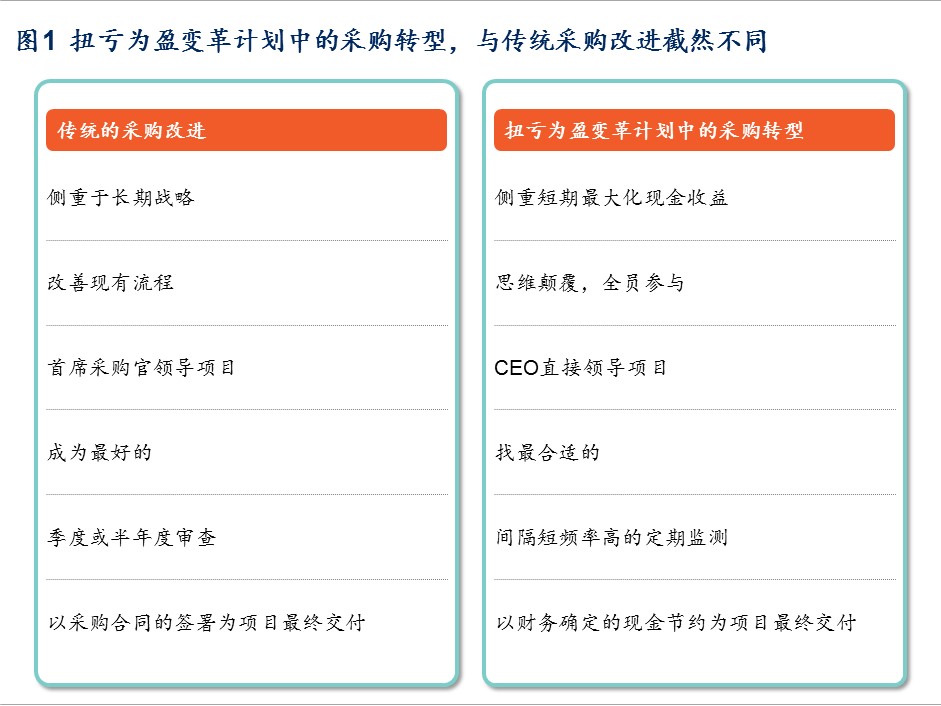
In fact, the Agile Procurement Transformation approach can be applied to any situation that requires significant and rapid cost reduction. In other words, although this approach originated in the plan of corporate restructuring and transformation, and turned a profit, it is not limited to this, and can be extended to other contexts. When CEOs have any cost reduction needs, the agile procurement transformation can have immediate results.
So, how should we carry out agile procurement transformation to achieve the goal of “thinning”? We have summarized the following three major steps:
• Establish a special procurement optimization project: the company must independently reduce external expenditures into a project, and make this project a priority for the entire management team, surpassing conventional annual procurement activities and traditional centralized procurement at a priority level;
• Establish an imperative mentality: Corporate executive teams need the courage and determination necessary, and at the same time they must mobilize employees, activate the "ownership" awareness of employees at all levels, and work together to achieve Common goals go forward;
• Establish performance evaluation standards: To ensure the efficient implementation of projects, companies also need to set specific performance evaluation standards to effectively evaluate project progress and ensure project effectiveness.
In order to help enterprises promote the transformation of agile procurement, we have extended the above three major steps in five dimensions of thought, management, method, plan, and process based on research and best practice experience, and summarized the following five guiding principles (see figure 2).

I. Motivate employees to establish a sense of "ownership"
Once employees have the “ownership” consciousness, they can help companies control their expenditures as they save money. Employees put themselves in the perspective of their bosses, thinking about how to save money, and they will carefully evaluate outsourcing contracts from the perspective of investors. The focus in their hearts is very clear: the sustainable development of the company is the first priority. Only by reaching such a high level of ideology will employees actually evaluate every expense, and try every means to save expenses.
Of course, for employees to establish this "ownership" consciousness, employees' consciousness is not enough. They must also rely on the unified transformation goals of the executive team, appropriate incentives and efficient mobilization. This means that companies must quickly adjust spending regulations from top to bottom, reduce non-critical spending items, and ensure that expenditures are reasonable. For example, companies can adjust the travel expenses of executives and employees at all levels, re-formulate purchase orders, and renegotiate purchase contracts.
In order to effectively avoid non-critical expenses, enterprises can adopt the "expenditure control tower" model at the specific operational level (see Figure 3). The "Expenditure Control Tower" can effectively manage indirect expenses, including contractor, staff costs, and other types of autonomous expenses. In the first month of implementation, it can save 15% to 30% of indirect expenses (see sidebar 1). It can also help businesses shift to a zero-based budget model. This change of thinking is very interesting. The previous expenditure logic was "I have a budget, and my expenditures come from the budget." The logic of the zero-based budget is "I have no budget, so every penny must be spent This will undoubtedly have a bottom-line effect on reducing expenditure.

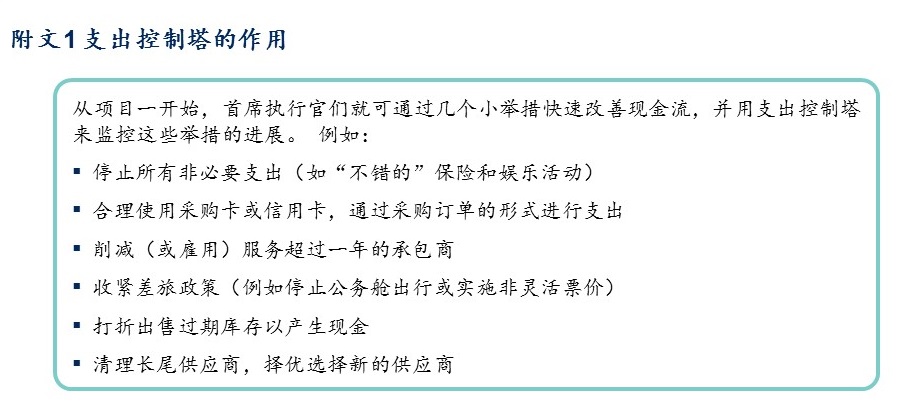
II:Ensuring the active participation of the CEO and the Board
In the past, the traditional procurement optimization project was led by the procurement department and cooperated with the business department. Everyone can complete the procurement plan while saving expenses. However, in the agile procurement transformation plan, the involvement of the CEO and board members is critical, and senior management needs to recognize the importance of reducing external expenditures and participate in concerted efforts. After all, as mentioned earlier, external expenditures typically account for 30% to 70% of a company's total expenditures, and effectively optimizing expenditures should be one of the top priorities of the CEO and the board of directors.
The CEO is the leader of the company's transformation and is responsible for triggering high-level rethinking of the operating model and the company's traditional way of thinking (see sidebar 2). The CEO must be a role model for the company in both words and deeds. By actively participating in various activities and setting an example, the CEO must strongly demonstrate his commitment and determination to lead the successful transformation of the entire enterprise. E.g:
• set an example for cutting expenses by flying in economy instead of business;
• Attend project team meetings, especially evaluation meetings on cost reduction, to help speed up the decision-making process;
• Reward outstanding individuals who help companies significantly reduce costs;
• Repeatedly emphasize the commitment to lead a successful transformation of the company and publicize the progress of the transformation.

III. Find suitable grabbers to release cash quickly
In order to maximize value, companies must also use the right methods. Make good use of grips and use capacity-building tools to achieve goals (see Figure 4). And use some technical tools, such as white paper analysis and product disassembly, to determine how much cost can be reduced. At the same time, companies need to make employees feel empathy and realize the value of these cost reduction measures.
However, if the company urgently needs cash, it is prudent to increase the speed of cost reduction before considering other expenses.
In order to see the maximum benefits of procurement transformation, it usually takes one to one and a half years, but if cross-sectoral cooperation is carried out, joint use of hands to release funds can greatly improve the efficiency of transformation (see sidebar 3).
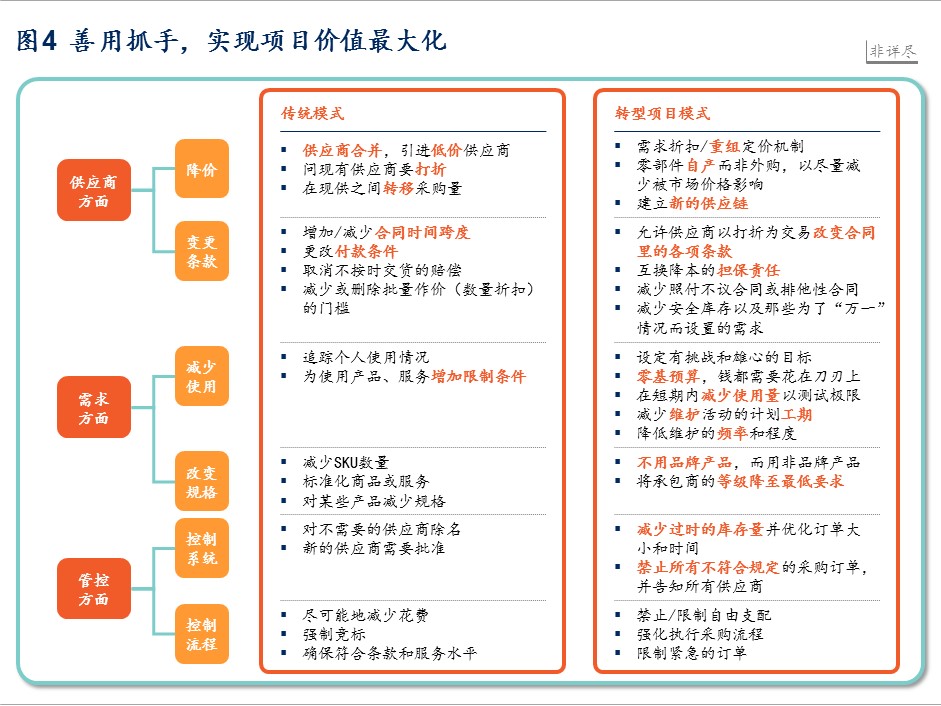
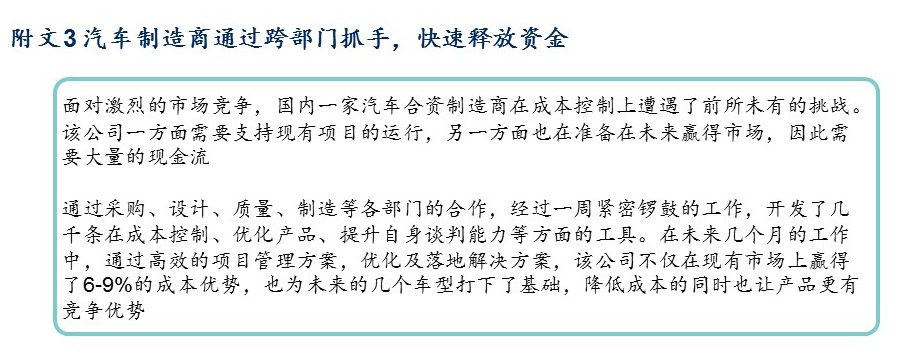
The benefits of transformation are an invaluable driver that can increase an organization's confidence in transformation. After generating a gripper, determine the priority and land quickly:
• Reasonable needs to help manage the scope of procurement activities;
• Reopen negotiation of contracts, formulate a schedule for future negotiations, provide a basis for project teams, and track contract progress;
• Estimate and manage off-contract expenditures through the Expenditure Control Tower. Clarify each purchase request, alternatives, scope of purchases, and cost reduction grasps, and run the control tower throughout the business to cultivate staff cost awareness.
IV. Keep improving and design a package of measures to drive value
In order to maximize the value of procurement delivery, the plan must clearly define the extension goals and responsible persons. The plan should be developed in collaboration with the procurement and business units, introducing as many initiatives as possible to bring value, and clarifying when they will be implemented. Only then can the company develop a deliverable plan. Specifically, the success of this plan is inseparable from five elements:
• Measures are developed to the details and these measures are negotiated with individual strategic suppliers;
• Setting extension goals for all initiatives, requiring procurement leaders to come up with bold ideas and challenge them;
• Give the purchasing manager control to the contract owner (that is, the requester of the purchase), but the latter can still accept the guidance of the former, so as to save and not waste
• Fine-tuned trackable project nodes to ensure progress feedback on the process. At the planning stage, it is necessary to ensure that the business unit is involved from beginning to end in order to finally receive cash benefits;
• Reliable analysis based on facts. Procurement and business units must work together to achieve their goals.
In order to obtain price reductions quickly through negotiation, the most effective method is to establish a "negotiating factory", which is a negotiation mechanism in which suppliers participate. The "Negotiation Factory" provides the negotiation team with a series of standardized practical tools, such as detailed RFQ pricing templates, best benchmarking analysis, negotiation scripts and negotiation scenario simulations. Those who are familiar with the business are not necessarily familiar with contract negotiation. This mechanism avoids this embarrassing situation and allows enterprises to deploy the best procurement resources in the negotiations and ensure the best negotiation results (see sidebar 4).
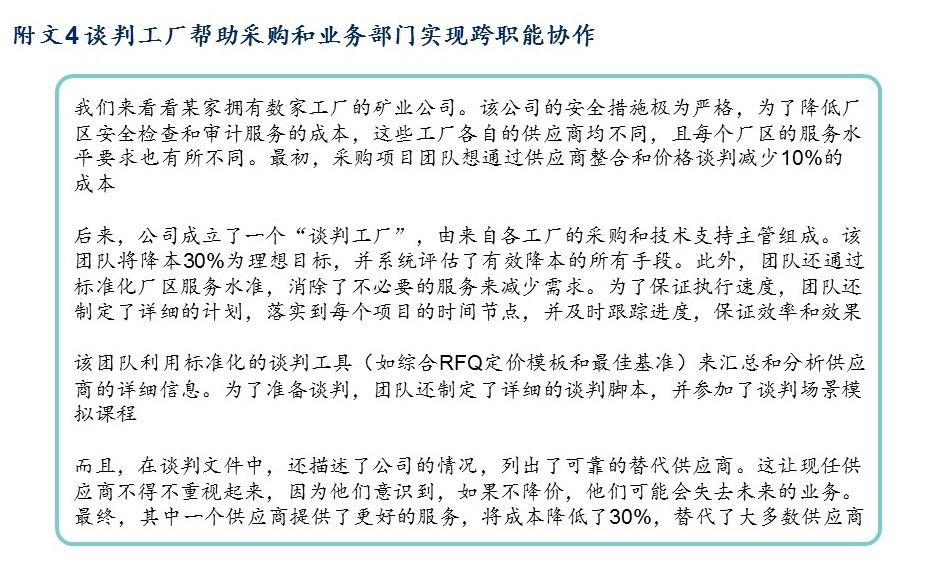
V. Establishing a stable foundation to ensure increased value
In rapid change, effective execution can ensure successful project implementation, while effective execution requires continuous performance evaluation. The company needs to formulate a detailed implementation plan, continuously monitor progress, and estimate completion time. Every cost reduction initiative should have detailed action arrangements, time nodes and responsible personnel, and clear incentives and long-term goals. To effectively track the process, three things need to be done:
• Keeping track of project nodes: Tracking project nodes weekly ensures that the plan is implemented as scheduled and issues can be quickly identified and resolved. Tracking progress also allows companies to pinpoint opportunities and accelerate project progress;
• Aim for strong goals: Track each initiative, respond to changes in goals and performance at any time to ensure real benefits, and quickly intervene if the desired results are not achieved
• Grasp cost reductions: Keep track of your actual financial bottom line to make sure your earnings are cashed in. Under normal circumstances, companies need to track project results on a monthly basis. If the company encounters a serious cash flow crisis, it may be necessary to establish an interim monitoring team and corresponding workflows to track it weekly.
In short, reducing external expenditure to achieve rapid cost reduction is not a one-time reform. In order to be able to continuously see the effect, the company must fundamentally change the procurement thinking of executives and employees at all levels of the enterprise. By adopting the above five principles, the company should cultivate "owner" thinking in the organization, carry out cross-functional cooperation, and increase the value of procurement. Companies that take the lead in agile procurement transformation can achieve superior procurement performance, thereby preemptively preempting them.

